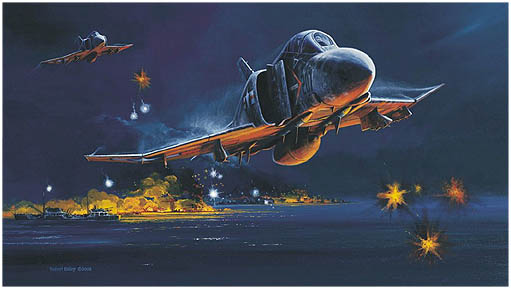|
 are acknowledged, affirmed and commemorated.
|
Posted on 12/19/2002 5:37:52 AM PST by SAMWolf
|
 are acknowledged, affirmed and commemorated.
|

| Our Mission: The FReeper Foxhole is dedicated to Veterans of our Nation's military forces and to others who are affected in their relationships with Veterans. We hope to provide an ongoing source of information about issues and problems that are specific to Veterans and resources that are available to Veterans and their families. In the FReeper Foxhole, Veterans or their family members should feel free to address their specific circumstances or whatever issues concern them in an atmosphere of peace, understanding, brotherhood and support.
|
|
|
|
The Christmas Bombing - 1972 Operation Linebacker II operations were initiated on 18 December 1972 and were directed by the Joint Chiefs of Staff (JCS) to continue until further notice. The primary objective of the bombing operation would be to force the North Vietnamese government to enter into purposeful negotiations concerning a cease-fire agreement. The operation employed air power to its maximum capabilities in an attempt to destroy all major target complexes such as radio stations, railroads, power plants, and airfields located in the Hanoi and Haiphong areas. Unlike previous bombing campaigns, Linebacker II provided the Air Force and U.S. Naval forces with specific objectives and removed many of the restrictions that had previously caused frustration within the Pentagon.  During these operations, Air Force and Navy tactical aircraft and B-52s commenced an around-the-clock bombardment of the North Vietnamese heartland. The B-52s struck Hanoi and Haiphong during hours of darkness with F-111s and Navy tactical aircraft providing diversionary/suppression strikes on airfields and surface-to-air missile sites. Daylight operations were primarily carried out by A-7s and F-4s bombing visually or with long-range navigation (LORAN) techniques, depending upon the weather over the targets. In addition, escort aircraft such as the Air Force EB-66s and Navy EA-6s broadcast electronic jamming signals to confuse the radar-controlled defenses of the North. The Strategic Air Command also provided KC-135s to support the in-flight refueling requirements of the various aircraft participating in Linebacker II operations. Andersen Air Force Base in Guam was the site of the most massive buildup of air power in history. More than 15,000 people and more than 150 B-52s lined all available space on the flightline. During Operation Linebacker II in December 1972, bombers stationed at Andersen flew 729 sorties in 11 days. Navy tactical air attack sorties under Linebacker II were centered in the coastal areas around Hanoi and Haiphong. There were 505 Navy sorties in this area during Linebacker II. The following carriers participated in Linebacker II operations: Enterprise, Saratoga, Oriskany, America and Ranger. Aircraft of the Seventh Fleet performed the most extensive aerial mining operation in history, blockading the enemy's main avenues of supply. The reseeding of the mine fields was resumed and concentrated strikes were carried out against surface-to-air missile and anti-aircraft artillery sites, enemy army barracks, petroleum storage areas, Haiphong Naval and shipyard areas, and railroad and truck stations.  Between 18 and 22 December the Navy conducted 119 Linebacker II strikes in North Vietnam. The attack effort was concentrated in the Haiphong area. Strikes were conducted against surface-to-air missile and anti-aircraft artillery installations, railroads and highways Thanh Hoa Army barracks, the Haiphong Naval Base, petroleum centers and other military related targets. Until the cease-fire ending US combat operations in Vietnam took effect on 28 January 1973, USS America and the other carriers ranged off the coast of Vietnam, conducting strike operations in support of troops and targeting strategic targets throughout North Vietnam. On 25 December 1972 a Christmas Day bombing/tactical air attack recess went into effect during which none of the US air services flew sorties. Heavy raids around Hanoi, which resumed the day after the Christmas bombing halt, were eased as NVN showed indications of returning to the conference table.  The impact of the bombing was obvious in the severe damage to the North Vietnamese logistic and war-support capability. By 29 December 1972, the 700 nighttime sorties flown by B-52s and 650 daytime strikes by fighter and attack aircraft persuaded the North Vietnamese government to return to the conference table. Linebacker II formally ended on 27 January 1973. Bad weather was the main limiting factor on the number of tactical air strikes flown during Linebacker II. Of 741 planned B-52 sorties, 12 were aborted. The Air Force SEAD (Suppression of Enemy Air Defenses) mission was carried out by F-105, F-4C, and F-4E fighters. CAP (combat air patrol), escort, and chaff dispersal were carried out by numerous types. In addition, US Navy and US Marine aircraft flew a total of 277 night support sorties in A-6, A-7, and F-4 aircraft.
|

Hi HiJinx, I know the feeling, I'm going to be running around most of the evening tonight so I'll be scarce until late. :-(
Linebacker II
AARDVARKS over Libya.......Ronny says Hello Gaddafi! 

Sarah Steenson, 2, is happy to be in the arms of her
father, Lt. Justin Steenson, after he returned from
deployment with the VAW-125 "Tigertails" at Norfolk
Naval Station on Thursday. The squadron of E-2C
Hawkeyes was part of the George Washington air wing.
Photo by Steve Earley / The Virginian-Pilot.
More

 Just flyin by
Just flyin by

Disclaimer: Opinions posted on Free Republic are those of the individual posters and do not necessarily represent the opinion of Free Republic or its management. All materials posted herein are protected by copyright law and the exemption for fair use of copyrighted works.